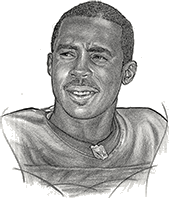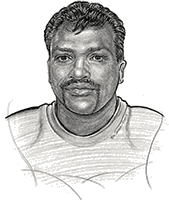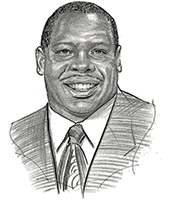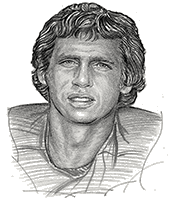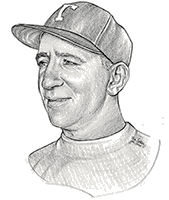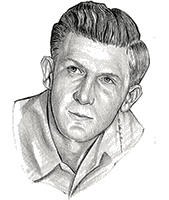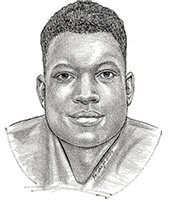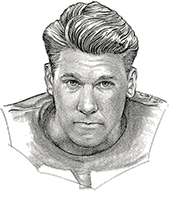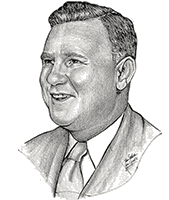In a nine-year span, which began on the neighborhood fields of Cleveland St. Joseph’s High and culminated in the plush surroundings of the Louisiana Superdome, Desmond Howard assembled a collection of football honors matched just twice before in the history of the sport. The talented speedster earned high school All-American honors as a tailback at St. Joseph’s in 1987, won the Heisman Trophy as a wide receiver for the University of Michigan in 1991, and collected the Super Bowl MVP award as the return specialist for the Green Bay Packers after the Packers’ 35-21 win over New England in Super Bowl XXXI in January, 1997. Those were but the crown jewels in a stunning set of accomplishments for Howard. At St. Joseph’s where he was also an All-Ohio two way player, he made USA Today’s High School Honor Roll by scoring five touchdowns in eight carries in a 41-28 victory over archrival Euclid. In his Heisman year as a Michigan senior, when he scored a school record 23 touchdowns and 138 points to become the first receiver to lead the Big Ten in scoring, he also garnered the Maxwell Award, the College Football Player of the Year Awards of The Sporting News and The Walter Camp Foundation player of the year award and was a unanimous first team All-American selection. Drafted by the Washington Redskins with the fourth pick in the 1992 NFL draft, Howard went on to play 11 seasons with five teams (the Redskins, Jaguars, Packers, Raiders and Lions), setting numerous team records for punt and/or kickoff returns in 1997, including a Super Bowl record 99-yard kickoff return which helped him to become the first special teams player to win the Super Bowl MVP trophy, and was named to the 2001 NFL Pro Bowl team. He retired after the 2002 season.
The persuasive conviction of a high school coach and the willingness of a college recruiter to take a gamble on a 6’3″ 185 lb linebacker paid handsome dividends for this East Cleveland native. Limited by an injury to only three football games as a senior at Shaw High, after playing in just seven varsity contests as an underclassman, he nevertheless found himself the recipient of a scholarship to West Virginia University. Good deal all around. In his sophomore year at WVU, he was All-East for the first of two seasons, and as a junior was getting All-American mention. After finishing his college career in 1982 as WVU’s career leader in assisted tackles and tackles for a loss, he was selected to nine All-American teams and became the school’s first consensus All-American in 27 years. Drafted by the Buffalo Bills in the second round of the 1983 draft (39th pick), he began an 11-year career which took him to Super Bowl appearances in 1990, 1991, 1992 and 1993, earned him selection to the 1990 and 1991 Pro Bowls and eventually to a place on the Bills’ Wall of Fame, the 20th player so honored. When he left the Bills in 1994, he took with him the honor of being Buffalo’s all-time leading tackler. He played for Atlanta in 1995 and Minnesota in 1996, then signed a contract with Buffalo in 1997 and retired—as a Bill. Darryl now makes his home in Orlando, Florida, where he runs a traffic control company.
Robert Smith was the best football player ever at Euclid High School—a two-time Mr. Ohio Football, Ohio’s Division 1 Back-of-the-Year in 1988 and 1989, gaining 5, 318 yards on 563 carries and scoring 71 touchdowns in three brilliant seasons. He led the Panthers to a 29-5 record, three Greater Cleveland Conference titles, and three trips to the state playoffs. As a result he was named not only a High School All-American as a senior, but the 1989 Gatorade Circle of Champions National High School Football Player of the Year and was also honored by the Washington TD Club as the Dial Soap High School Player of the Year. Taking his talents next to Ohio State, he shattered the revered Archie Griffin’s freshman rushing record, running for 1,126 yards in his first year. After leading the Buckeyes in rushing as a junior in 1992, he entered the NFL draft, where he became the first round (21st overall) pick of the Minnesota Vikings in 1993. Despite a series of injuries, he won recognition as one of the NFL’s best running backs over the ensuing eight seasons, rushing for a club record 6,818 yards and being named to the 1998 and 2000 Pro Bowls. His best season came in 2000 when he rushed for 1,521 yards to lead the NFC. It was the only season in which he was able to play in all 16 games of the campaign. But after undergoing his third knee surgery, he elected to retire from football at the age of 28. Now the co-owner of a software company with another Cleveland football standout Tom Cousineau, and owner of a construction company, he currently makes his home in Pembroke Pines, Florida.
Native Clevelander Tom Jackson launched his illustrious football career at John Adams High where he starred for two seasons before moving on to the University of Louisville in 1969. After winning Missouri Valley Conference Player of the Year honors as a sophomore in 1970 and as a senior in 1971, he began a history-making 14-year career with the Denver Broncos of the NFL in 1973. When his career ended, he had played the most games (191) in Broncos history, a total since surpassed by John Elway, who is also the only player to have played more seasons (16) with Denver. Jackson made three consecutive Pro Bowl appearances from 1977 through 1979, was named All-Pro in 1977 and 1978 and was the Broncos defensive MVP in 1974, ’76 and ’77. In 1977 he was also named the AFC “Linebacker of the Year” and was voted the team’s “Most Inspirational Player” for six straight seasons. Six years after his retirement in 1986 he was inducted into the Broncos Ring of Fame, an honor reserved for Denver’s all-time best players. He became a television football analyst after his playing days ended and is currently seen on ESPN’s NFL Primetime and NFL Sunday and Monday Night Countdown shows. He presently makes his home in Cincinnati.
Brian Dowling is an athletic legend at St. Ignatius High School. He led his team to a City Basketball title, sinking four clutch free throws in the title game’s last 34 seconds to turn a 13 point deficit into a 53-50 victory. He also made the state tennis doubles finals as a sophomore and the regional singles finals as a senior. But it was as a football quarterback that Dowling achieved bigger-than-life status. In six high school and college seasons he played in just one losing game, when, as a prep junior in 1963, injuries sent him to a hospital at half-time of the City Championship Charity Game. He avenged that loss in the following year’s Charity Game, breaking loose for a 71-yard TD run and passing for four touchdowns in a 48-6 rout. At Yale, his teams were 21-0-1 in games he played and 5-6 in games he missed with injuries. The tie came in his final collegiate game when Harvard scored 16 points in the final 42 seconds to earn a 29-29 draw and a share of the Ivy League title with Yale. The previous year, his 66 yard touchdown pass with 2:16 left had beaten the Crimson 24-22 for the Ivy League Crown. An honorable mention All-American and the Outstanding Player in New England as a senior, he currently lives in Lowell, Massachusetts.
Fine all-around star for Cleveland West tech High in 1920, ’21 and ’22, he continued his career at Ohio State University, lettering in football, basketball and baseball for three seasons and captaining the 1926 Buckeye football team. As backfield coach at Texas A & M he was credited with developing All-American John Kimbrough. A pro baseball player briefly, he became head baseball coach at Ohio State in 1951 and produced an NCAA championship nine in 1966.
Ranked among the best athletes to come out of Cleveland West High, he starred in football, basketball and track there, twice winning the state high hurdle championships (1934 and 1935). Excelled in football on the University of Michigan team quarterbacked by Tom Harmon, was Big Ten high hurdles champion in track and was good enough in baseball to be signed to a pro contract by Washington. Was lost in action in World War II.
An all-scholastic lineman at Cleveland East Tech High in 1922 and 1923, he was hailed as one of the finest high school prospects of his time to come out of the Cleveland area. Went to Iowa State University where he collapsed and died in his first collegiate game.
An All-American halfback at the University of Notre Dame in 1943, he was called “the best back I ever coached” by storied Head Coach Frank Leahy. Had punting average of 49.2 yards as a sophomore, rushed for 5.9-yard average as a junior. Was a #1 pro football draft choice, but passed up the game to attend law school at Yale University. Was seventh member of famed family to play for the Fighting Irish.
A three-year all-scholastic football star at Cleveland South High, he an All-American center for Ohio State University in 1935, playing in only one losing game in three years for the Buckeyes. Became head football coach and athletic director at Oklahoma University in 1964 after 16 years as line coach, during which he produced 16 All-Americans. Also coached at John Carroll, Ohio State and Nebraska Universities.
2001 Crocker Rd., Ste. 510, Westlake, OH 44145
Phone: 216-241-1919

